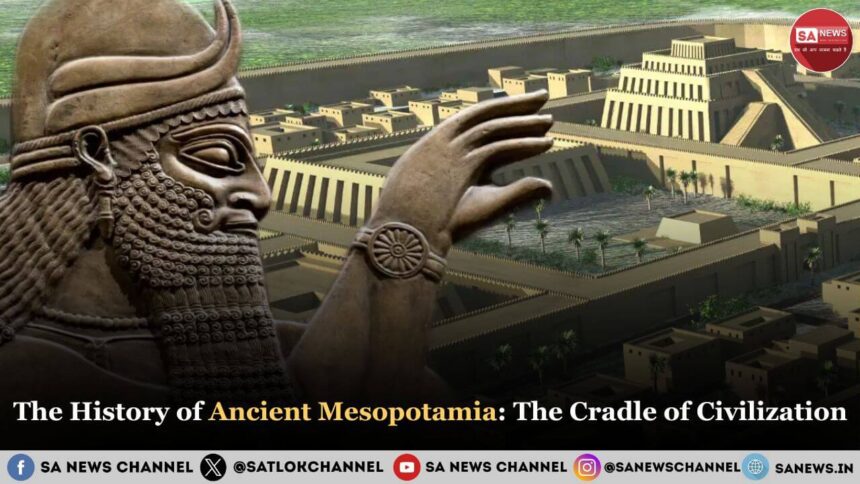From the rise of the Sumerians to the fall of the Neo-Babylonian Empire, Mesopotamia saw the emergence of powerful empires, scientific advancements, legal codes, and military innovations that influenced future civilizations. This article explores the history of Mesopotamia from 10,000 BCE to 539 BCE, detailing its major periods and contributions.
- 1. Prehistoric Mesopotamia (10,000–3500 BCE)
- The Ubaid Period (6500–4100 BCE)
- The Uruk Period (4100–3100 BCE)
- 2. The Sumerian Civilization (3500–2334 BCE)
- 3. The Akkadian Empire (2334–2154 BCE)
- 4. The Third Dynasty of Ur (2112–2004 BCE)
- 5. The Babylonian Empire (1894–1595 BCE)
- 6. The Assyrian Empire (1365–609 BCE)
- 7. The Neo-Babylonian Empire (626–539 BCE)
- The Enduring Legacy of Mesopotamia
- Spiritual Perspective
- FAQs on Ancient Mesopotamia
Mesopotamia, often referred to as the Cradle of Civilization, lies between the Tigris and Euphrates Rivers in what is modern-day Iraq, Syria, and parts of Turkey and Iran. The term “Mesopotamia” is derived from the Greek words meaning “land between rivers.”
This region is known for being the birthplace of many foundational developments that shaped human history, including the earliest cities, the invention of writing, organized governance, and technological innovations in fields like mathematics, astronomy, and engineering. This article delves into the history of Mesopotamia, from its prehistoric roots to the rise and fall of major empires, and explores how its contributions still resonate today.
1. Prehistoric Mesopotamia (10,000–3500 BCE)
The Neolithic Revolution
Around 10,000 BCE, Mesopotamia transitioned from hunter-gatherer societies to settled agricultural communities, marking the beginning of the Neolithic Revolution. This shift allowed people to build permanent settlements, cultivate crops like wheat and barley, and domesticate animals. Early villages such as Jarmo, Hassuna, and Halaf began to emerge, with inhabitants developing rudimentary forms of agriculture, pottery, and weaving.
The Ubaid Period (6500–4100 BCE)
The Ubaid period is considered the first stage of true civilization in Mesopotamia. During this time, people started to form complex social structures and engage in organized labor. The city of Eridu (around 5400 BCE) emerged as one of the earliest known cities in the world. Large-scale irrigation systems were developed to control the flooding of the rivers, ensuring fertile land for agriculture. Temples were built for religious worship, marking the early stage of urbanization.
The Uruk Period (4100–3100 BCE)
The Uruk period marks the rise of the first true city, Uruk, with a population that reached up to 50,000 people. Uruk was the center of trade, culture, and religion in the region. During this period, the invention of cuneiform writing occurred, around 3100 BCE. Cuneiform was initially used for keeping records of trade transactions but eventually evolved to record stories, laws, and administrative matters.
Also Read: The History of the Persian Empire: A Journey Through Time
The period also saw the construction of massive ziggurats, or stepped temples, which would later become a hallmark of Mesopotamian architecture.
2. The Sumerian Civilization (3500–2334 BCE)
The First City-States
The Sumerians are credited with establishing the first true civilization in Mesopotamia. By around 3500 BCE, Sumerian city-states like Uruk, Ur, Lagash, and Nippur were flourishing. Each city-state was governed by a king or lugal, who ruled both politically and religiously. The Sumerians practiced a polytheistic religion, with gods like Anu (god of the heavens), Enlil (god of wind and storms), and Inanna (goddess of love and war) central to their belief system.
Sumerian Achievements
Sumerians made incredible contributions to humanity, particularly in the realm of writing. Cuneiform, one of the earliest writing systems, was used not only for documenting legal matters and administrative tasks but also for literary works such as the Epic of Gilgamesh, the world’s first known literary epic. Additionally, the Sumerians developed the wheel, a revolutionary invention that greatly impacted transportation and pottery. Their use of a base-60 numeral system laid the groundwork for future advancements in mathematics and timekeeping.
Decline of Sumer
Although Sumerian civilization reached remarkable heights, it was weakened by constant internal warfare between city-states. Around 2334 BCE, Sargon of Akkad, a military leader from the city of Akkad, overthrew the Sumerian city-states, marking the beginning of the first empire in history—the Akkadian Empire.
3. The Akkadian Empire (2334–2154 BCE)
Sargon the Great: The First Empire Builder
Sargon of Akkad, often referred to as Sargon the Great, established the Akkadian Empire in 2334 BCE. By uniting the Sumerian city-states under one rule, Sargon created the world’s first empire. He made Akkad the capital of his empire and spread Akkadian as the official language, which eventually replaced Sumerian as the dominant language in the region. Sargon’s empire extended from the Persian Gulf in the south to parts of Syria, Anatolia, and Iran in the north.
Akkadian Contributions
Under Sargon’s leadership, the Akkadians standardized weights and measures, making trade more efficient. Sargon’s military also introduced key innovations such as composite bows and the use of professional standing armies, which greatly enhanced the empire’s military power.
Decline of Akkad
The Akkadian Empire began to collapse around 2154 BCE due to internal revolts and external invasions, notably from the Gutians (a group from the Zagros Mountains). The empire’s downfall marked the beginning of a period of instability in the region, but it paved the way for the rise of the Third Dynasty of Ur.
4. The Third Dynasty of Ur (2112–2004 BCE)
The Neo-Sumerian Revival
After the fall of the Akkadian Empire, the Sumerians experienced a brief revival under the Third Dynasty of Ur. Founded by Ur-Nammu, this dynasty saw the rebuilding of Sumerian culture, including religious temples, city infrastructures, and legal codes. Ur-Nammu’s Code (around 2100 BCE) is considered the earliest known legal code, even predating Hammurabi’s famous code.
Achievements of Ur III
Under Ur-Nammu and his successors, Ur became a center of culture and power once again. The dynasty constructed grand ziggurats, including the Great Ziggurat of Ur, and developed a sophisticated bureaucratic system with organized taxation and record-keeping.
Decline of Ur III
Around 2004 BCE, the Elamites sacked Ur, bringing an end to the Third Dynasty and marking the decline of Sumerian dominance in Mesopotamia.
5. The Babylonian Empire (1894–1595 BCE)
Hammurabi and the Golden Age of Babylon
The Babylonian Empire rose to prominence under King Hammurabi (r. 1792–1750 BCE). Hammurabi was a shrewd military leader who expanded his territory through conquest and diplomacy. He is most famous for creating the Code of Hammurabi, one of the earliest and most complete written legal codes in history, which governed various aspects of life, from property disputes to criminal justice. Under Hammurabi’s rule, Babylon became a thriving cultural, economic, and political hub.
Decline of Babylon
In 1595 BCE, the Hittites invaded and sacked Babylon, temporarily ending its dominance. Following the fall of Babylon, the Kassites ruled the region for the next 400 years, though their rule did not have the same lasting influence.
6. The Assyrian Empire (1365–609 BCE)
A Militaristic Power
The Assyrian Empire was known for its military prowess and its ability to conquer vast territories through superior tactics. Tiglath-Pileser III (r. 745–727 BCE) is credited with reforming the Assyrian military and expanding the empire. His successor, Sennacherib (r. 705–681 BCE), is famous for rebuilding the Assyrian capital Nineveh and destroying Babylon, demonstrating the empire’s ruthlessness.
Assyrian Achievements
The Assyrians were also cultural patrons, most notably preserving many ancient texts in the Library of Ashurbanipal. Furthermore, they pioneered the use of cavalry in battle and implemented mass deportations to suppress rebellions and maintain control over conquered peoples.
Collapse of Assyria
The Assyrian Empire fell in 612 BCE when a coalition of Babylonians and Medes destroyed Nineveh, marking the empire’s final downfall.
7. The Neo-Babylonian Empire (626–539 BCE)
Nebuchadnezzar II: Babylon’s Greatest King
The Neo-Babylonian Empire reached its zenith under Nebuchadnezzar II (r. 605–562 BCE). Nebuchadnezzar is best known for rebuilding Babylon into one of the most magnificent cities of the ancient world. Among his accomplishments were the construction of the Ishtar Gate and the legendary Hanging Gardens of Babylon, one of the Seven Wonders of the Ancient World.
Fall of Babylon
In 539 BCE, the Persian king Cyrus the Great conquered Babylon, marking the end of the Neo-Babylonian Empire.
Contributions of Mesopotamian Civilization
Writing and Literature
The invention of cuneiform allowed Mesopotamians to record everything from business transactions to great literary works, including the Epic of Gilgamesh.
Legal Systems
The Code of Hammurabi and Ur-Nammu’s Code laid the groundwork for modern legal systems.
Science and Mathematics
The base-60 system developed by the Sumerians influenced timekeeping and geometry.
Engineering and Architecture
Mesopotamian civilizations left behind impressive ziggurats and irrigation systems, while their cities were meticulously planned.
Military Innovations
The Assyrians, in particular, revolutionized warfare with their use of iron weapons and siege tactics.
The Enduring Legacy of Mesopotamia
The civilizations of ancient Mesopotamia laid the foundations for many aspects of modern life. Their innovations in writing, law, mathematics, and architecture continue to influence us today. Despite the rise and fall of powerful empires such as the Sumerians, Akkadians, Babylonians, Assyrians, and Neo-Babylonians, the contributions of Mesopotamian civilizations have left a lasting imprint on the world. Their legacy lives on in the form of ancient texts, archaeological discoveries, and scientific principles that continue to shape contemporary culture and knowledge.
Spiritual Perspective
Insights from Mesopotamia and Sant Rampal Ji
Ancient Mesopotamia stands as a remarkable testament to human achievement, marking the birth of civilization with innovations that still resonate today. The Sumerians, Akkadians, Babylonians, and Assyrians pioneered critical aspects of society—such as the invention of writing, legal codes, and monumental architecture.
The wisdom they imparted through their systems of governance, law, and urban planning laid the groundwork for much of human progress. Their contributions are still woven into the fabric of modern life, from the concept of time to the principles of justice and engineering.
In a similar light, the teachings of Sant Rampal Ji Maharaj provide profound spiritual wisdom that transcends time. Just as Mesopotamia focused on advancing material civilization, Sant Rampal Ji emphasizes the importance of spiritual knowledge and divine connection. His teachings remind us that while worldly achievements are valuable, true fulfillment is found through understanding the purpose of life, seeking the Supreme Being and worshiping with devotion and sincerity.
Sant Rampal Ji’s teachings highlight the power of knowledge whether it shapes societies or elevates the soul. In a world often driven by material pursuits, Sant Rampal Ji guides us to remember that spiritual awakening is the ultimate goal, offering a path to inner peace and lasting fulfillment.
FAQs on Ancient Mesopotamia
Why is Mesopotamia called the Cradle of Civilization?
Mesopotamia is called the Cradle of Civilization because it was home to the world’s first cities, writing system (cuneiform), organized governments, and legal codes. It laid the foundation for many aspects of modern society.
What were the major civilizations of Mesopotamia?
The major civilizations included the Sumerians, Akkadians, Babylonians, Assyrians, and Neo-Babylonians. Each contributed significantly to law, science, warfare, and culture.
What was the Code of Hammurabi?
The Code of Hammurabi was one of the earliest written legal systems, created by King Hammurabi of Babylon (c. 1754 BCE). It established strict laws based on the principle of “an eye for an eye” and influenced future legal systems.
What are some key inventions of Mesopotamia?
Mesopotamians invented writing (cuneiform), the wheel, irrigation systems, the base-60 mathematical system, calendars, and advanced architecture (ziggurats). These innovations shaped human progress.
How did Mesopotamia decline?
Mesopotamian civilizations declined due to invasions, internal conflicts, and environmental challenges. The Persians conquered Babylon in 539 BCE, marking the end of Mesopotamian rule. However, its cultural and scientific legacy lived on.









